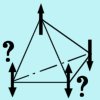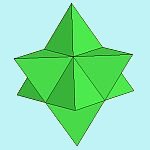



|
|
|
|
|
|
|
|
Research Interests
I. METAL-INSULATOR TRANSITIONS
II. GEOMETRICALLY FRUSTRATED MAGNETIC MATERIALS
III. SEARCH FOR NEW MATERIALS
|
|
||||||||||||
| Research Interests | ||||||||||||
|
|
||||||||||||
Geometrically Frustrated Magnetic Materials |
||||||||||||
|
|
||||||||||||
|
||||||||||||
|
Consider now the case of Figure 1b, where the spins are on the corners of an equilateral triangle. Here there is a strong geometric impediment to spin ordering as only two of the three spins can be aligned antiparallel simultaneously. This situation is called geometric magnetic frustration. Things are worse in three dimensions, Figure 1c, as illustrated by the tetrahedron where now two of the four spins are frustrated. The effects of geometric frustration are realized only in extended systems where the triangles and tetrahedra share corners, edges and sometimes faces to form a periodic, repeating array, some examples of which are seen in Figures 2a-d. There exist many real materials which are based on frustrated lattices such as these and it remains a challenge to discover and synthesize new ones. |
||||||||||||
|
||||||||||||
|
Why is there interest in geometrically frustrated magnetic materials? It is precisely because the presence of frustration prevents the easy formation of spin-ordered states such as Figure 1a and instead, exotic ground states are found such as spin glasses (where the spins freeze in a random pattern), spin liquids (where the spins interact strongly but remain fluctuating down to temperatures near absolute zero) and the spin ice (a special case of the spin liquid) which is related to the problem of proton disorder in water ice. Little is known or understood about these unusual states of matter and much attention has been paid over the past ten years or so. Our group has played a pioneering role in the development of this field which is inherently interdisciplinary, involving collaboration between chemists, physicists and materials scientists. We have been at the forefront of efforts to discover and synthesize new frustrated magnetic materials, recent examples of which include BaCr10O15 (ref: 1996-#174), Li2Mn2O4(ref: 1999-#206), Gd2Ti2O7 (ref: 1999-#202) and Li4MgReO6(ref: 2000-#220). In addition to synthesis, we also carry out basic magnetic measurements, specific heat and neutron diffraction studies (the single most important tool in the study of magnetic materials). This field has been reviewed recently (ref: 2001-#223) and this article provides many additional examples and further details. |
||||||||||||
|
© 2009 J.E. Greedan / McMaster University All Rights Reserved Last updated: |
||||||||||||






